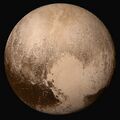Astronomy:HD 164595 b
| Discovery | |
|---|---|
| Discovered by | Courcol et al. |
| Discovery date | 10 September 2015 |
| Radial velocity | |
| Orbital characteristics | |
| 0.23 AU (34,000,000 km)[1] | |
| Eccentricity | 0.0880+0.1200 −0.0660[1] |
| Orbital period | 40.00±0.24[1] d |
| Star | HD 164595 |
| Physical characteristics | |
| Mass | 16.14±2.72[1] M⊕ |
HD 164595 b is a confirmed exoplanet orbiting around a Sun-like star HD 164595 every 40 days some 94.36 light-years away. It was detected with the radial velocity technique with the SOPHIE echelle spectrograph. The planet has a minimal mass equivalent of 16 Earths.[1][2]
It is believed to be a Neptune-like gassy planet incapable of supporting life.[3][4] The planet has a minimal mass of 16 Earth masses.[1]
Possible radio signal from star system
A recent (2016) radio signal at 11 GHz (2.7 cm wavelength) has been observed from the HD 164595 stellar system.[5][6] It is unknown which planet of that stellar system is involved, if any. It could instead be gravitational lensing from a more distant source.[6] SETI investigators are looking into it,[6][7][8] but the chances of the signal being from an extraterrestrial civilization are considered slim, at best,"[3] with SETI researcher Eric Korpela calling it "uninteresting".[9]
References
- ↑ 1.0 1.1 1.2 1.3 1.4 1.5 "HD 164595 b Confirmed Planet Overview Page". NASA. http://exoplanetarchive.ipac.caltech.edu/cgi-bin/DisplayOverview/nph-DisplayOverview?objname=HD+164595+b&type=CONFIRMED_PLANET.
- ↑ Courcol, Bastien; Bouchy, François; Pepe, Francesco; Santerne, Alexandre; Delfosse, Xavier; Arnold, Luc; Astudillo-Defru, Nicola; Boisse, Isabelle et al. (2015-09-01). "The SOPHIE search for northern extrasolar planets" (in en). Astronomy & Astrophysics 581: A38. doi:10.1051/0004-6361/201526329. ISSN 0004-6361. Bibcode: 2015A&A...581A..38C. http://www.aanda.org/10.1051/0004-6361/201526329.
- ↑ 3.0 3.1 Plait, Phil (31 August 2016). "No, We Almost Certainly Did Not Detect an Alien Signal". Slate. http://www.slate.com/blogs/bad_astronomy/2016/08/31/russia_astronomers_see_possible_signal_from_nearby_star.html.
- ↑ Moody, Oliver (31 August 2016). "PAYWALL - Title => Signal from the stars could be ET phoning Earth". The Times. http://www.thetimes.co.uk/article/signal-from-the-stars-could-be-et-phoning-earth-kndtv6wpv.
- ↑ Gilster, Paul (27 August 2016). "An Interesting SETI Candidate in Hercules". Centauri Dreams. http://www.centauri-dreams.org/?p=36248.
- ↑ 6.0 6.1 6.2 Griffiths, James (30 August 2016). "Hear me now? 'Strong signal' from sun-like star sparks alien speculation". CNN. http://www.cnn.com/2016/08/30/health/seti-signal-hd-164595-alien-civilization/index.html.
- ↑ SETI observations on the RATAN-600 telescope in 2015 and detection of a strong signal in the direction of HD 164595 Bursov N., Filippova L., Filippov V., Gindilis L., Maccone C. et al. 2016 | in " IAA SETI Permanent Committee", Guadalajara, Mexico.
- ↑ Staff (29 August 2016). "Mystery radio signal may be from distant star system – or a military transmitter". KurzweilAI. http://www.kurzweilai.net/mystery-radio-signal-may-be-from-distant-star-system-or-a-military-transmitter.
- ↑ Korpela, Eric (29 August 2016). "Uninteresting from a SETI point of view". http://setiathome.berkeley.edu/forum_thread.php?id=80193.
 |




